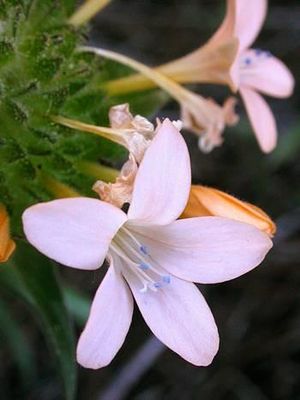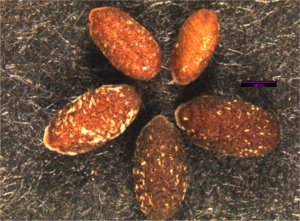Difference between revisions of "Collomia grandiflora"
m (Tag: VisualEditor) |
(→Description) (Tag: VisualEditor) |
||
| (9 intermediate revisions by the same user not shown) | |||
| Line 1: | Line 1: | ||
| − | * | + | * Scientific Name: ''Collomia'' ''grandiflora'' |
* Family: Polemoniaceae | * Family: Polemoniaceae | ||
* Common Names: large-flowered collomia, large-flower mountain-trumpet | * Common Names: large-flowered collomia, large-flower mountain-trumpet | ||
* Codon: COLGRA | * Codon: COLGRA | ||
| − | + | ---- | |
| + | [[File:COGRX BenLegler flw good.jpg |thumb|Photo by Ben Legler, 2004. Also featured on Main Page]] | ||
=== Taxonomy === | === Taxonomy === | ||
{{Taxobox | {{Taxobox | ||
| − | | name = | + | | name = |
| − | | image = | + | | image = |
| image_caption =Photo by Ben Legler, 2004. Also featured on Main Page | | image_caption =Photo by Ben Legler, 2004. Also featured on Main Page | ||
| regnum = [[Plant]]ae | | regnum = [[Plant]]ae | ||
| − | | subregnum = | + | | subregnum = Viridiplantae |
| − | | phylum = | + | | phylum = Tracheophyta |
| − | | subphylum= | + | | subphylum= Spermatophytina |
| classis = Magnoliopsida | | classis = Magnoliopsida | ||
| subclassis = Asteranae | | subclassis = Asteranae | ||
| ordo = Ericales | | ordo = Ericales | ||
| familia = Polemoniaceae | | familia = Polemoniaceae | ||
| − | | genus = | + | | genus = ''Collomia'' Nutt. |
| species = '''''Collomia grandiflora''''' Douglas ex. Lindl | | species = '''''Collomia grandiflora''''' Douglas ex. Lindl | ||
}} | }} | ||
| + | <ref>Integrated Taxonomic Information System. Retrieved from https://www.itis.gov/servlet/SingleRpt/SingleRpt?search_topic=TSN&search_value=31037</ref> | ||
| − | == Description == | + | === Description === |
| − | + | Annual herb growing from taproot with terminal clusters of salmon to white-colored flowers, up to 1 m tall.<ref name=":0">WTU Herbarium, Burke Museum, & University of Washington. Retrieved from https://biology.burke.washington.edu/herbarium/imagecollection/taxon.php?Taxon=Collomia%20grandiflora</ref> Stems simple or with axillary branching,<ref name=":0" /> white haired.<ref name=":1">Hitchcock, C. L., Cronquist, A., Giblin, D., | |
| + | & Legler, B. et al. (2018). ''Flora of the Pacific Northwest: an | ||
| + | illustrated manual''. Seattle: University of Washington Press. p. 384.</ref> Leaves alternate, entire, lanceolate, to 8 cm long.<ref name=":0" /> Inflorescences capitate.<ref>Jepson Herbarium Online Flora. Retrieved from https://ucjeps.berkeley.edu/eflora/eflora_display.php?tid=20021</ref> Flowers radially symmetrical, 5-merous; calyx 5-lobed, tubular; corolla tubular-funnelform, 5 lobed; stamens 5, epipetalous;<ref name=":1" /> pistil 3-carpellate with trifid stigma, superior ovary becoming a loculicidal capsule.<ref>Hitchcock, C. L., Cronquist, A., Giblin, D., | ||
| + | & Legler, B. et al. (2018). ''Flora of the Pacific Northwest: an | ||
| + | illustrated manual''. Seattle: University of Washington Press. p. 382.</ref> | ||
| − | + | === Bloom Period === | |
| + | May-August<ref name=":0" /> | ||
| − | + | === Distribution === | |
| + | Widely distributed across Washington; British Columbia to California, east to Rocky Mountains.<ref name=":0" /> | ||
| + | === Habitat === | ||
| + | Open, moist to rather dry areas, low to moderate elevations.<ref name=":0" /> | ||
| + | === Uses === | ||
| + | Infusion of roots or of leaves and stalks taken by Okanogan-Colville as a laxative; Infusion of roots taken by Okanogan-Colville for high fevers; Use of leaves by Paiute and others as a protective covering for filled berry containers.<ref>Native | ||
| + | American Ethnobotany Database. Retrieved from http://naeb.brit.org/uses/search/?string=Collomia+grandiflora</ref> | ||
| − | + | === Propagation === | |
| − | + | [http://naeb.brit.org/uses/search/?string=Collomia+grandiflora Native Plant Network Propagation Protocol] | |
| − | + | ||
| − | + | ||
| − | + | ||
| − | + | ||
| − | + | ||
| − | + | ||
| − | + | ||
| − | + | ||
| − | + | ||
| − | + | ||
| − | + | ||
| − | + | ||
| − | + | ||
| − | + | ||
| − | + | ||
| − | + | ||
[[File:COGR.png|thumb|right|300px|''Collomia grandiflora'' seeds <br> Photo Credit Lisa HIntz]] | [[File:COGR.png|thumb|right|300px|''Collomia grandiflora'' seeds <br> Photo Credit Lisa HIntz]] | ||
| Line 76: | Line 73: | ||
{{Basics}} | {{Basics}} | ||
| − | = | + | === Photo Gallery === |
| − | == Photo Gallery == | + | |
<gallery> | <gallery> | ||
File:COGRX BenLegler flw1 good.jpg|Photo: Ben Legler | File:COGRX BenLegler flw1 good.jpg|Photo: Ben Legler | ||
| Line 83: | Line 79: | ||
File:COLGRA3.jpg|Young growth, courtesy of CNLM | File:COLGRA3.jpg|Young growth, courtesy of CNLM | ||
</gallery> | </gallery> | ||
| + | |||
| + | ===References=== | ||
| + | <references /> | ||
Latest revision as of 14:33, 28 June 2021
- Scientific Name: Collomia grandiflora
- Family: Polemoniaceae
- Common Names: large-flowered collomia, large-flower mountain-trumpet
- Codon: COLGRA
Contents
Taxonomy
| Scientific classification | |
|---|---|
| Kingdom: | Plantae |
| Subkingdom: | Viridiplantae |
| Phylum: | Tracheophyta |
| Subphylum: | Spermatophytina |
| Class: | Magnoliopsida |
| Subclass: | Asteranae |
| Order: | Ericales |
| Family: | Polemoniaceae |
| Genus: | Collomia Nutt. |
| Species: | Collomia grandiflora Douglas ex. Lindl |
Description
Annual herb growing from taproot with terminal clusters of salmon to white-colored flowers, up to 1 m tall.[2] Stems simple or with axillary branching,[2] white haired.[3] Leaves alternate, entire, lanceolate, to 8 cm long.[2] Inflorescences capitate.[4] Flowers radially symmetrical, 5-merous; calyx 5-lobed, tubular; corolla tubular-funnelform, 5 lobed; stamens 5, epipetalous;[3] pistil 3-carpellate with trifid stigma, superior ovary becoming a loculicidal capsule.[5]
Bloom Period
May-August[2]
Distribution
Widely distributed across Washington; British Columbia to California, east to Rocky Mountains.[2]
Habitat
Open, moist to rather dry areas, low to moderate elevations.[2]
Uses
Infusion of roots or of leaves and stalks taken by Okanogan-Colville as a laxative; Infusion of roots taken by Okanogan-Colville for high fevers; Use of leaves by Paiute and others as a protective covering for filled berry containers.[6]
Propagation
Native Plant Network Propagation Protocol
Seed
Abbreviation: COGRX
Seed sample from: 2011
Average measurement: 3 x 1.5 x 1.1
Measurement range: L: 2.75 - 3.1 W: 1.2 x 1.7 D: 0.9 x 1.3
Features
Shape: One end of seed is slightly more rounded than other. This is the hilium end. One side of seed has longitudinal sulcus that does not reach the hilium or opposite apex.
Color: Hilium indistinct. Entire seed surface mostly uniform in color. Seed is brown with some white spots that are flakey looking.
Surface:Entire seed is very bumpy, sometimes slightly ridged. When wet, seed coat forms many clear, mucilaginous threads.
Could be confused with: Gilia capitata
Latitudinal cross section: elliptical ![]()
Longitudinal cross section: elliptical ![]()
Basic Explanations and Assumptions:
The dimensions for the seeds are length x width x depth. The location of the hilum is used as the base of the seed, and the length is measured from hilum to the opposite apex. Where a style is present, the length is measured from the hilum to the bottom of the style. Width is measured at a right angle to the length at the widest part. Depth is measured at a right angle to the intersection of height and width lines.
Measurements included are the mean average for each measurement of ten separate seeds.
All measurements in millimeters unless otherwise noted.
Photo Gallery
References
- ↑ Integrated Taxonomic Information System. Retrieved from https://www.itis.gov/servlet/SingleRpt/SingleRpt?search_topic=TSN&search_value=31037
- ↑ 2.0 2.1 2.2 2.3 2.4 2.5 WTU Herbarium, Burke Museum, & University of Washington. Retrieved from https://biology.burke.washington.edu/herbarium/imagecollection/taxon.php?Taxon=Collomia%20grandiflora
- ↑ 3.0 3.1 Hitchcock, C. L., Cronquist, A., Giblin, D., & Legler, B. et al. (2018). Flora of the Pacific Northwest: an illustrated manual. Seattle: University of Washington Press. p. 384.
- ↑ Jepson Herbarium Online Flora. Retrieved from https://ucjeps.berkeley.edu/eflora/eflora_display.php?tid=20021
- ↑ Hitchcock, C. L., Cronquist, A., Giblin, D., & Legler, B. et al. (2018). Flora of the Pacific Northwest: an illustrated manual. Seattle: University of Washington Press. p. 382.
- ↑ Native American Ethnobotany Database. Retrieved from http://naeb.brit.org/uses/search/?string=Collomia+grandiflora





